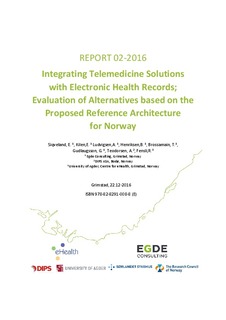| dc.contributor.author | Siqveland, Elisabeth S | |
| dc.contributor.author | Kilen, Elin | |
| dc.contributor.author | Ludvigsen, Ann-Elisabeth | |
| dc.contributor.author | Henriksen, Bjørnar | |
| dc.contributor.author | Brossamain, Thomas | |
| dc.contributor.author | Gudlaugsson, Gunnar | |
| dc.contributor.author | Teodorsen, A | |
| dc.contributor.author | Fensli, Rune Werner | |
| dc.date.accessioned | 2017-02-08T12:57:12Z | |
| dc.date.available | 2017-02-08T12:57:12Z | |
| dc.date.created | 2017-02-01T11:18:21Z | |
| dc.date.issued | 2016 | |
| dc.identifier.isbn | 978-82-8291-008-8 | |
| dc.identifier.uri | http://hdl.handle.net/11250/2430015 | |
| dc.description.abstract | This report studies the way forward for how a telemedicine solution can be integrated for exchange of data with an existing Electronic Health Record (EHR) system. The solution used an example for this report is based on a telemedicine solution for COPD patients (Chronic Obstructive Pulmonary Disease) developed in the project “Collaborative Point-of-Care Services Agder: Follow-up of COPD patients as part of the United4Health EU Project», with financial support from the Research Council of Norway. In addition, the EHR solution from DIPS ASA is used as an example of an existing system for integration. Important parameters for choosing way forward on how to are: • urgency with regards to timeline • level of structuring of the data. • compliance with the reference architecture proposed by the Norwegian Directorate of eHealth (NDE) Three alternative ways forward are discussed in this report, based on four different scenarios with their respectively defined use-cases. Possibilities of integration exists already today which may support one of the use cases in the simplest way, but may not be a futureproof solution regarding functionality and recommended standards. Such a solution is supported by DIPS Classic as well as DIPS Arena by using HL7 V3 interface in DIPS. The journal data may be stored in an unstructured way as a PDF document in a patients EHR. To send structured data from a Telemedicine System to an EHR will be the preferred way for the future, and will support several use cases in a more efficient way. This will require more work in total and is dependent on other parties (external storage, DIPS etc) for building infrastructure and new interfaces. Such solutions will still be of high interest in the future. This report describes two different scenarios for how such solutions can be implemented in the future using either external storage and XDS.b or using FHIR/OpenEHR. Which of these alternatives that will be the leading standard or best practice is hard to predict, since it will highly depend on how the user requirements from the health care market will request such solutions, and how the standardization requirements from National authorities evolves in the next years. In addition, it depends on how the developers/vendors of both telemedicine solutions and EHR-systems will responds to these requirements. | nb_NO |
| dc.language.iso | eng | nb_NO |
| dc.publisher | Senter for eHelse, Universitetet i Agder | nb_NO |
| dc.subject | Telemedisin | nb_NO |
| dc.subject | Telemedicine | nb_NO |
| dc.subject | Standardisering | nb_NO |
| dc.subject | Standardisation | nb_NO |
| dc.title | Integrating Telemedicine Solutions with Electronic Health Records; Evaluation of Alternatives based on the Proposed Reference Architecture for Norway | nb_NO |
| dc.type | Research report | nb_NO |
| dc.subject.nsi | VDP::Medisinsk teknologi: 620 | nb_NO |
| dc.subject.nsi | VDP::Medical technology: 620 | nb_NO |
| dc.source.pagenumber | 29 | nb_NO |
| dc.identifier.cristin | 1445201 | |
| dc.relation.project | Norges forskningsråd: 227131/O70 | nb_NO |
| cristin.unitcode | 201,15,4,0 | |
| cristin.unitname | Institutt for informasjons- og kommunikasjonsteknologi | |
| cristin.ispublished | true | |
| cristin.fulltext | original | |
